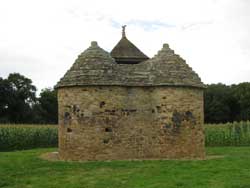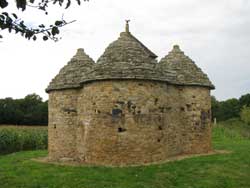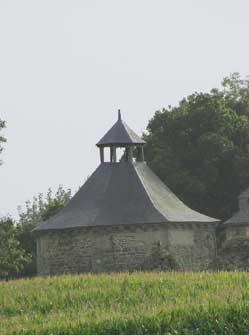
 |
 |
| Dovecote of Planguenoual |
The design of the Planguenoual dovecote with the four towers joined to a square base is absolutely unique, and is a must see for any enthusiast. What is even more fortunate is that this dovecote is on public property, maintained by the town, and open for inspection and admiration. Another dovecote in the area that is open for public inspection lies just a few miles to the west at Hillion. While not near as elaborate or unusual in its construction it is certainly worth a visit. We visited the Hillion dovecote the next day, quite by accident, because we were unaware of its existance. Dr. Jean Auffret reports that it was definitely known in the 16th century, being mentioned in a deed of gift in 1513 per Marguerite of Rochefort to her husband, Jean Métaër. Thirteen dovecotes strewed the region of Planguenoual during the 16th century, but by 1690, only eight remained. I wonder how many remain today? Perhaps this is the sole survivor. Mr. Gautier, of Mottay, described the unusual arrangement of the nest holes being aligned rather than of the standard checkerboard pattern. This dovecote has a very large number of nest holes , with over 1,060. There was a stone basin in the center, which received rain water intended to water pigeons.
The builders used large varied stones of the country: granite, rosy sandstone, and dark brown sandstone, called fox. It is designed as a central square of about 16 feet per side with each corner of the square having an attached tower of about three feet in diameter. These towers increase the capacity of the dovecote significantly. The towers have a stone vaulted roof that is handsomely capped with a nipple made of a circular flat stone. Each tower's roof merges into the main vaulted roof that is also made of stone, but with a rather large opening. This is the single opening and provides more than ample light, as well as providing the pigeons with ingress and egress. This center opening is topped with a bold cupola.
The rainwater catch, as noted by Mr. Mottay above, though interesting, would probably not have been very efficient as the water would have become stale rather quickly, and fresh water can be taken readily from outside sources for these free flying birds. It may have well have originally have been designed to simplify the gathering of the dung. It was clearly part of the original design, though, since the unique design with the four corners expanded into tight diameter columns, would not have entertained a potence efficiently.This very clever unique design, though, accounts for the very large number of nest holes, particularly considering its rather modest footprint and height. There are 380 holes in the center square flat walls, and the four round columns have 171 holes each composed of 19 rows of 9 holes, adding up to684 holes for the columns, and totaling 1,064 for the entire structure. A large number indeed for this otherwise rather compact structure. Dovecotes with a similar number of nestholes are either taller or have a larger overall footprint on the land. The holes in this dovecote also extend all the way to the floor. Though not particularly practical, they do increase the overall capacity. The nestholes are not of the standard checkerboard pattern, but the interiors do curve alternatly from left to right, alternating by row. No landing ledges are provided. Entry to the dovecote is gained from the center cupola directly above the square portion of the structure, rather than from the four connected towers.
The dovecote was remarkably restored thanks to the association of the "Friends of Vaujoyeux," and was classified as a historic building in 1981. With the reconstruction, a very interesting cap of a pigeon was placed on the main entrance cupola. I do not know if this was a reproduction of the previous cap or a more modern artistic rendition, but in either case it provides the desired artistic aim well.
The town fathers are rightly proud of the work and have made finding this most unique dovecote very simple. There are multiple signs directing you to the dovecote from the moment you enter the town welcoming you to Planguenoual, to where to turn off the main highway and even one for the layout of the town near the city hall. The dovecote is at number 10. I wonder what the British think about that.
 |
|---|
| Dovecote the Ville Meneuc in Saint Lormel |
 |
| Dovecote La Ville Roze |
The castle is noted as the mansion of Richard Lesquen who lived there from 1427 to 1498. It is rather unusual for a dovecote of this area, being octagonal rather then round. Octagon-shaped dovecotes are much less common than the cicular type in Brittany. The only other octagon dovecote we located was at La Gravelle. The walls appear to be made of rubble, with the exception of the corner joints, which are made of larger cut stones and set in the method seen around doorways and brickwork. The roof, including that of the cupola, is slate. The cupola is held by eight ornamented stone poles, further accentuating the octagon effect. The roof, where it meets the wall is very nicely accented with an inverted crenellation look by what appear to be the beams for the roof, but are actually large shaped stone work.
The drive and property of the castle de la Ville Meneuc at St. Lormel is noted as private, but it can be seen across the fields from the public road by traveling north out of Plancoet for 3km on the D19 and then taking the very next successive right turns.
We failed to locate this dovecote, whose previous owners had a direct involvement in the American revolution. It reportedly lies on a very small road between Plancoët and Lamballe in or near the forsest of Hundaudaye. Perhaps a reader of this page who is familiar with the area can provide more detailed information.
On the road, very near to our gite, La Garaye, was this converted dovecote attached to the house La Ville Roze. What gives it away as a dovecote is the landing board on the top inlet, which has now been changed to a very small window for the stairway for the main structure. This is above the area needed for the stairway into the house and would have served admirably well as a small dovecote.
It is quite similar to that of the manor of Toul Year Collet A Plesidy, which we travelled to the next day. Of course, one can’t be 100% percent certain, but no other reasonable explanation exists for a small window, higher that what would be needed for entry into the second floor, and then with a landing ledge no less. And originally constructing such a large external staircase for a rather modest size home is not a better explanation.
It lies north on the D2, about 8.5 kilometers from the E41/N176 freeway just past Trigavou.
The next day we continued or travels in the vicinity and to the west of St. Brieuc ![]()
DAY |
||||||||||||||||||
| 00 | 01 | 02 | 03 | 04 | 05 | 07 | 08 | 09 | 10 | 11 | 12 | 13 | 14 | 15 | 16 | 17 | 18 | |